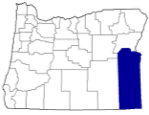When political realities come up against ecological realities, the former must be changed because the latter cannot.
Read MoreAbout That Vision Thing

Wild and Scenic Rivers
When political realities come up against ecological realities, the former must be changed because the latter cannot.
Read MoreCongress told the Bureau of Land Management to remove a small, but fish-damaging, dam on the Donner und Blitzen Wild and Scenic River and the Steens Mountain Wilderness. The BLM may finally get around to it.
Read MoreUnderstanding the history of public lands is useful if one is to be the best advocate for the conservation of public lands.
Read MoreA giant in nature conservation and restoration died just a few days short of the autumnal equinox. Like few others, he inspired generations of advocates of wildlands, wild waters, and wildlife to reach for the greater good and to demand more.
Read MoreBlumenauer’s bill would open up Mount Hood National Forest to new logging loopholes.
Read MoreThis is the third of three Public Lands Blog posts on 30x30, President Biden’s commitment to conserve 30 percent of the nation’s lands and waters by 2030. In Part 1, we examined the pace and scale necessary to attain 30x30. In Part 2, we considered what constitutes protected areas actually being “conserved.” In this Part 3, we offer up specific conservation recommendations that, if implemented, will result in the United States achieving 30 percent by 2030.
Top Line: Enough conservation recipes are offered here to achieve 50x50 (the ultimate necessity) if all are executed, which is what the science says is necessary to conserve our natural security—a vital part of our national security.
Figure 1. The Coglan Buttes lie west of Lake Abert in Lake County, Oregon. According to the Bureau of Land Management, it “is a dream area for lovers of the remote outdoors, offering over 60,000 acres of isolation,” and the land is “easy to access but difficult to traverse.” The agency has acknowledged that the area is special in that it is a “land with wilderness characteristics” (LWCs), but affords the area no special protection. Congress could designate the area as part of the National Wilderness Preservation System (Recipe #24), or the Biden administration could classify it as a wilderness study area and also withdraw it from the threat of mining (Recipe #1). Source: Lisa McNee, Bureau of Land Management (Flickr).
Ecological realities are immutable. While political realities are mutable, the latter don’t change on their own. Fortunately, there are two major paths to change the conservation status of federal public lands: through administrative action and through congressional action.
Ideally, Congress will enact enough legislation during the remainder of the decade to attain 30x30. An Act of Congress that protects federal public land is as permanent as conservation of land in the United States can get. If properly drafted, an Act of Congress can provide federal land management agencies with a mandate for strong and enduring preservation of biological diversity.
If Congress does not choose to act in this manner, the administration can protect federal public land everywhere but in Alaska. Fortunately, Congress has delegated many powers over the nation’s public lands to either the Secretary of the Interior or the Secretary of Agriculture (for the National Forest System), and—in the sole case of proclaiming national monuments—the President.
Potential Administrative Action
Twenty-two recipes are offered in Table 1 for administrative action by the Secretary of the Interior, the Secretary of Agriculture, or the President. The recipes are not mutually exclusive, especially within an administering agency, but can be overlapping or alternative conservation actions on the same lands. While overlapping conservation designations can be desirable, no double counting should be allowed in determining 30x30. A common ingredient in all is that such areas must be administratively withdrawn from all forms of mineral exploitation for the maximum twenty years allowed by law.
Mining on Federal Public Lands
An important distinction between federal public lands with GAP 1 or GAP 2 status and those with lesser GAP status is based on whether mining is allowed. Federal law on mineral exploitation or protection from mining on federal public lands dates back to the latter part of the nineteenth century with the enactment of the general mining law. Today, the exploitation of federal minerals is either by location, leasing, or sale. The administering agency has the ability to say no to leasing and sale, but not to filing of mining claims by anyone in all locations open to such claiming.
When establishing a conservation area on federal lands, Congress routinely withdraws the lands from location, leasing, or sale. Unfortunately, when administrative action elevates the conservation status of federal public lands (such as Forest Service inventoried roadless areas or IRAs, Bureau of Land Management areas of critical environmental concern or ACECs, and Fish and Wildlife Service national wildlife refuges carved out of other federal land), it doesn’t automatically protect the special area from mining.
Congress has provided that the only way an area can be withdrawn from the application of the federal mining laws is for the Secretary of the Interior (or subcabinet officials also confirmed by Congress for their posts) to withdraw the lands from mining—and then only for a maximum of twenty years (though the withdrawal can be renewed). A major reason that particular USFS IRAs and BLM ACECs do not qualify for GAP 1 or GAP 2 status is that they are open to mining.
More Conservation in Alaska by Administrative Action: Fuggedaboutit!
The Alaska National Interest Lands Act of 1980 contains a provision prohibiting any “future executive branch action” withdrawing more than 5,000 acres “in the aggregate” unless Congress passes a “joint resolution of approval within one year” (16 USC 3213). Note that 5,000 acres is 0.0012 percent of the total area of Alaska. Congress should repeal this prohibition of new national monuments, new national wildlife refuges, or other effective administrative conservation in the nation’s largest state. Until Congress so acts, no administrative action in Alaska can make any material contribution to 30x30.
Potential Congressional Action
Twenty-two recipes are offered in Table 2 for congressional action. The recipes are not mutually exclusive, especially within an administering agency, but can be overlapping or alternative conservation actions on the same lands. However, they should not be double-counted for the purpose of attaining 30x30. A commonality among these congressional actions is that each explicitly or implicitly calls for the preservation of biological diversity and also promulgates a comprehensive mineral withdrawal.
Bottom Line: To increase the pace to achieve the goal, the federal government must add at least three zeros to the size of traditional conservation actions. Rather than individual new wilderness bills averaging 100,000 acres, new wilderness bills should sum hundreds of millions of acres—and promptly be enacted into law. Rather than a relatively few new national monuments mostly proclaimed in election years, many new national monuments must be proclaimed every year.
For More Information
Kerr, Andy. 2022. Forty-Four Conservation Recipes for 30x30: A Cookbook of 22 Administrative and 22 Legislative Opportunities for Government Action to Protect 30 Percent of US Lands by 2030. The Larch Company, Ashland, OR, and Washington, DC.
To permanently protect 30 percent of its lands by 2030, the US must conserve 114,183 acres of land per day—with no time off for weekends and holidays.
Read MoreNearly 4,700 miles of Oregon’s free-flowing streams will be added to the National Wild and Scenic Rivers System if legislation introduced this past Wednesday by Senator Ron Wyden (D-OR) becomes law.
Read MoreIf not for the Cold War (1945–1991), there might well have been a national park in Oregon’s Cascade Mountains.
Read MoreLegislation introduced by New Mexico’s two Democratic US senators would severely undermine the integrity of the National Wild and Scenic Rivers System.
Read MoreMalheur is the French word for adversity, misfortune, and/or tragedy. It is also, among other things, a name for a county in Oregon, a national forest, a national wildlife refuge, and a river. Senator Ron Wyden’s proposed Malheur Community Empowerment for the Owyhee Act is indeed a misfortune and a tragedy.
Read MoreMap 1. The Smith River watershed in Oregon and California. Source: Wikipedia.
Senator Jeff Merkley has introduced in Congress the proposed “Smith River National Recreation Area Expansion Act” (S.2875), which would expand the Smith River NRA to include all 58,000 acres of the Smith River watershed in Oregon.
Read MoreSenator Ron Wyden (D-OR) is asking his constituents to nominate possible new wild and scenic rivers for Oregon. You have until January 20, 2020. Don’t forget! Some Oregon river is (or some Oregon rivers are) depending on you.
Read MoreSenator Ron Wyden (D-OR) is asking his constituents to nominate possible new wild and scenic rivers for Oregon. You have until January 20, 2020. This opportunity is unprecedented and potentially historic. All hands on deck!
Read MoreFigure 1. Darlingtonia California, a carnivorous plant, along Rough and Ready Creek in a watershed of extraordinary biological diversity. The watershed is threatened with nickel mining, and wild and scenic river status would help end the mining threat. Source: Sandy Lonsdale. First appeared in Oregon Wild: Endangered Forest Wilderness by the author.
While Oregon leads the nation in number of units in the National Wild and Scenic Rivers System (NWSRS), Oregon trails in (1) total number of protected wild and scenic river miles, (2) total acreage within the NWSRS, and (3) percentage of the state’s total stream mileage protected in the NWSRS.
Read MoreFig. 1. Crabtree Lake in Crabtree Valley, which contains some of the oldest trees in Oregon, is in the proposed Douglas Fir National Monument, located in Oregon’s Cascade Mountains. Source: David Stone, Wildlands Photography. Previously appeared in Oregon Wild: Endangered Forest Wilderness (Timber Press, 2004), by the author.
Less than a week after President Trump signed the Oregon Wildlands Act into law (as one of many bills in the John D. Dingell, Jr., Conservation, Management, and Recreation Act), Senator Ron Wyden (D-OR) and Representative Earl Blumenauer (D-3rd-OR) convened an Oregon Public Lands Forum on Monday, March 18, 2019.
Read MoreIn play right now in Congress are two bills that would elevate the conservation status of 442,620 acres of public land in Oregon.
Read MoreWhen Representative Greg Walden (R-2nd-OR) hears “the Rogue,” he happily dreams of the roar of chainsaws. But now Walden is down and Representative Peter DeFazio (D-4th-OR) is up, and the stars have aligned to save the Wild Rogue. You can help.
Read MoreGrasslands get little respect. So easily are they converted to agriculture that grasslands are the least protected biome on Earth.
Read More












